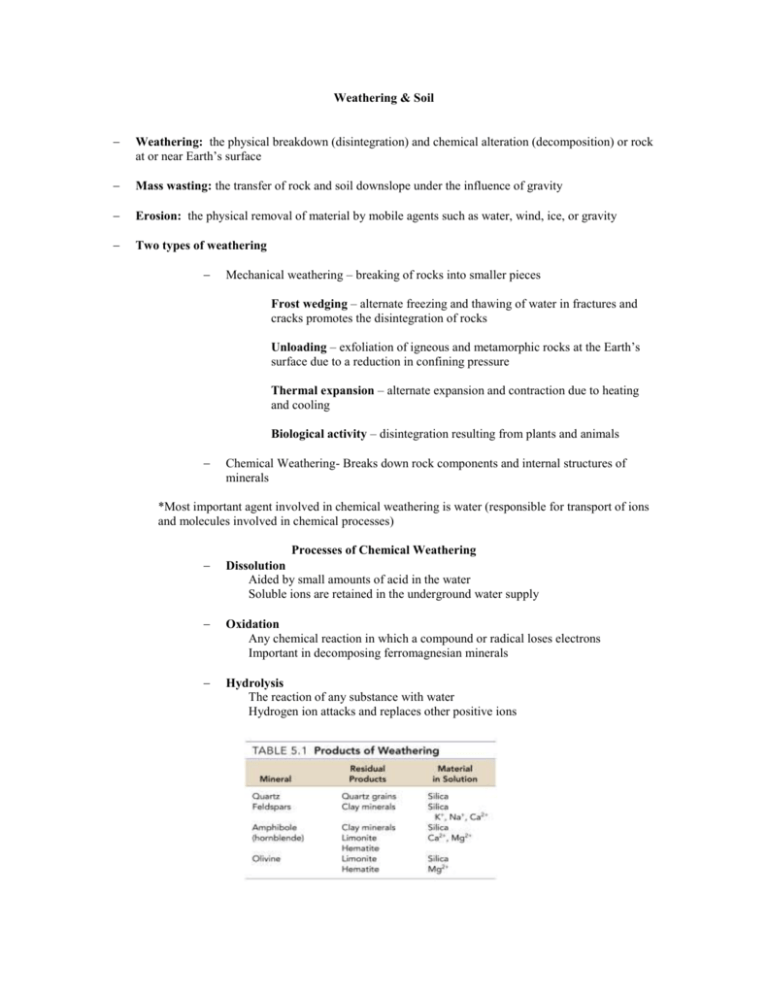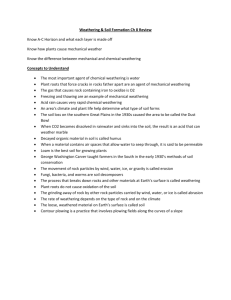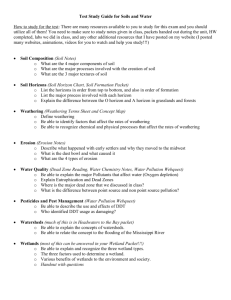Weathering & Soil
advertisement

Weathering & Soil Weathering: the physical breakdown (disintegration) and chemical alteration (decomposition) or rock at or near Earth’s surface Mass wasting: the transfer of rock and soil downslope under the influence of gravity Erosion: the physical removal of material by mobile agents such as water, wind, ice, or gravity Two types of weathering Mechanical weathering – breaking of rocks into smaller pieces Frost wedging – alternate freezing and thawing of water in fractures and cracks promotes the disintegration of rocks Unloading – exfoliation of igneous and metamorphic rocks at the Earth’s surface due to a reduction in confining pressure Thermal expansion – alternate expansion and contraction due to heating and cooling Biological activity – disintegration resulting from plants and animals Chemical Weathering- Breaks down rock components and internal structures of minerals *Most important agent involved in chemical weathering is water (responsible for transport of ions and molecules involved in chemical processes) Processes of Chemical Weathering Dissolution Aided by small amounts of acid in the water Soluble ions are retained in the underground water supply Oxidation Any chemical reaction in which a compound or radical loses electrons Important in decomposing ferromagnesian minerals Hydrolysis The reaction of any substance with water Hydrogen ion attacks and replaces other positive ions Alterations caused by chemical weathering Decomposition of unstable minerals Generation or retention of materials that are stable Physical changes such as the rounding of corners or edges Rates of weathering Advanced mechanical weathering aids chemical weathering by increasing the surface area Others factors affecting weathering Rock characteristics Rocks containing calcite (marble and limestone) readily dissolve in weakly acidic solutions Silicate minerals weather in the same order as their order of crystallization Climate Temperature and moisture are the most crucial factors Chemical weathering is most effective in areas of warm, moist climates Differential weathering Masses of rock do not weather uniformly due to regional and local factors Results in many unusual and spectacular rock formations and landforms Differential Weathering due to jointing Soil Soil is a combination of mineral and organic mater, water, and air That portion of the regolith (rock and mineral fragments produced by weathering) that supports the growth of plants Factors controlling soil formation Parent material Residual soil – parent material is the underlying bedrock Transported soil – forms in place on parent material that has been carried from elsewhere and deposited Factors controlling Soil Formation Time Important in all geologic processes Amount of time for soil formation varies for different soils depending on geologic and climatic conditions Climate Most influential control of soil formation Key factors are temperature and precipitation Plants and animals Organisms influence the soil’s physical and chemical properties Also furnish organic matter to the soil Slope Steep slopes often have poorly developed soils Optimum terrain is a flat-to-undulating upland surface The soil profile Soil forming processes operate from the surface downward Vertical differences are called horizons – zones or layers of soil O horizon – organic matter A horizon – organic and mineral matter High biological activity Together the O and A horizons make up the topsoil E horizon – little organic matter Zone of eluviation and leaching B horizon – zone of accumulation C horizon – partially altered parent material The O, A, E, and B horizons together are called the solum, or “true soil”








